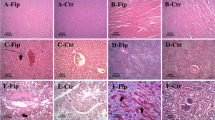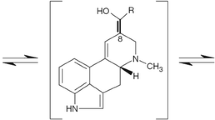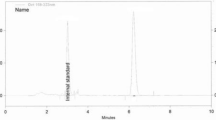Abstract
The metabolism of xanthotoxin, a naturally occurring furanocoumarin photosensitizer, was studied in laying hens and a lactating goat treated with single oral doses equivalent to 10 mg xanthotoxin/kg of body weight. Within 48 h, essentially all of the administered radiocarbon was eliminated in the excreta of the laying hens, while in the goat 92% and 3% were excreted in the urine and feces, respectively. Radiocarbon residues in the milk, egg white, and egg yolk were low. Xanthotoxin, 8-hydroxypsoralen (xanthotoxol), 6-(7-hydroxy-8-methoxycoumaryl)-acetic acid (HCA) and 6-(7-hydroxy-8-methoxycoumaryl)-hydroxyacetic acid (HCHA) were identified in the excreta of laying hens. In the goat, xanthotoxin was metabolized to HCA, HCHA, xanthotoxol, 5,8-dihydroxypsoralen, psoralenquinone, 5-hydroxy-8-methoxy-psoralen and 3[5-(6-hydroxy-7-methoxybenzofuryl)]-propanoic acid. Thus, identified metabolites in one or both of these species arose throughO-demethylation, oxidative cleavage of the furan ring, hydroxylation, reduction, oxidation, and hydrolysis of the lactone ring.
Similar content being viewed by others
References
Ashwood-Smith, M.J., Ceska, O., andChaudhary, S.K. 1985. Mechanism of photosensitivity reactions to diseased celery.Br. Med. J. 290:1249.
Beier, R.C., Ivie, G.W., andOertli, E.H. 1983. Psoralens as phytoalexins in food plants of the familyUmbelliferae, pp. 295–310,in J.W. Finley, D.E. Schwass (eds.). Xenobiotics in Foods and Feeds. ACS Symposium Series 234, American Chemical Society, Washington, D.C.
Bleehen, S.S., Villa, Briffa, andWarin, A.P. 1978. Photochemotherapy in mycosis fungoides.Clin. Exp. Dermatol. 3:377–387.
Card, L.E., andNesheim, M.C. 1973.In Poultry Production, 11th ed. Lea & Febiger, Philadelphia, Pennsylvania.
Chaudhary, S.K., Ceska, O., Warrington, P.J., andAshwood-Smith, M.J. 1985. Increased furanocoumarin content of celery during storage.J. Agric. Food Chem. 33:1153–1157.
Davis, C.N., Davis, L.E., andPowers, T.E. 1975. Comparative body compositions of dog and goat.Am. J. Vet. Res. 36:309–311.
Dollahite, J.W., Younger, R.L., andHoffman, G.O. 1978. Photosensitization in cattle and sheep caused by feedingAmmi majus (greater Ammi; bishop's weed).J. Am. Vet. Med. Assoc. 39:193–197.
Edelson, R., Berger, C., Gasparro, F., Jegasothy, B., Heald, P., Wintroub, B., Vonderheid, E., Knobler, R., Wolff, K., Plewig, G., McKiernan, G., Christiansen, I., Oster, M., Honigsmann, H., Wilford, H., Kokoschka, K., Rehle, T., Perez, M., Stingl, G., andLaroche, L. 1987. Treatment of cutaneous T-cell lymphoma by extracorporeal photochemotherapy,N. Engl. J. Med. 316:297–303.
Egyed, M.N., Shlosberg, A., andEilat, A. 1977. Photosensitizing effects of furocoumarin containing weeds on domestic birds.Vet. Hum. Toxicol. 19:11–13.
Eilat, A., Malkinson, M., Shlosberg, A., andEgyed, M.N. 1974. A field outbreak of photosensitization in goslings caused by the ingestion ofAmmi majus.Refu. Vet. 31:83–86.
Ennis Jr., M.E., Johnson, J.E., Ward, G.M., andBoamah, K.N. 1989. Technetium metabolism by lactating goats.Health Phys. 57:321–330.
Ikeda, G.J., Sapienza, P.P., Sager, A.O., andKornhauser, A. 1990. Excretion and tissue distribution of14C-labelled 8-methoxypsoralen in beagle dogs and miniature pigs.Food Chem. Toxicol. 28:333–338.
Ivie, G.W. 1982. Chemical and biochemical aspects of photosensitization in livestock and poultry.J. Natl. Cancer Inst. 69:259–262.
Ivie, G.W., Holt, D.L., andIvey, M.C. 1981. Natural toxicants in human foods: Psoralens in raw and cooked parsnip root.Science 213:909–910.
Ivie, G.W., Bull, D.L., Beier, R.C., Pryor, N.W., andOertli, E.H. 1983. Metabolic detoxification: Mechanism of insect resistance to plant psoralens.Science 221:374–376.
Ivie, G.W., Beier, R.C., Bull, D.L., andOertli, E.H. 1986. Fate of [14C]xanthotoxin (8-methoxypsoralen) in a goat and in bovine ruminai fluid.Am. J. Vet. Res. 47:799–803.
Kolis, S.J., Williams, T.H., Postma, E.J., Sasso, G.J., Confalone, P.N., andSchwartz, M.A. 1979. The metabolism of14C-methoxsalen by the dog.Drug Metab. Dispos. 7:220–225.
Mays, D.C., Rogers, S.L., Guiler, R.C., Sharp, D.E., Hecht, S.G., Staubus, A.E., andGerber, N. 1986. Disposition of 8-methoxypsoralen in the rat: Methodology for measurement, dose-dependent pharmacokinetics, tissue distribution and identification of metabolites.J. Pharmacol. Exp. Ther. 236:364–373.
Pangilinan, N. 1990. Fate of [14C]xanthotoxin (8-methoxypsoralen) in laying hens and lactating goats. PhD thesis. Texas A&M University, College Station, Texas.
Parrish, J.A., Fritzpatrick, T.B., Tanenbaum, L., andPathak, M. 1974. Photochemotherapy of psoriasis with oral methoxsalen and longwave ultraviolet light.N. Engl. J. Med. 291:1207–1211.
Pathak, M.A., Daniels, F., andFitzpatrick, T.B. 1962. The presently known distribution of furocoumarins (psoralens) in plants.J. Invest. Dermatol. 39:225–249.
Perelman, B., Perlstein, Z., Gur-Lavi, A., andEgyed, M.N. 1987. Clinical description of a field outbreak of photosensitization affecting different avian species.Isr. J. Vet. Med. 43:76.
Rowe, L.D., Norman, J.O., Corrier, D.E., Casteel, S.W., Rector, B.S., Bailey, E.M., Schuster, J.L., andReagor, J.C. 1987. Photosensitization of cattle in southeast Texas: Identification of phototoxic activity associated withCooperia pedunculata.Am. J. Vet. Res. 48:1658–1661.
Schmid, J., Prox, A., Reuter, A., Zipp, H., andKoss, F.W. 1980. The metabolism of 8-methoxypsoralen in man.Eur. J. Drug. Metab. Pharmacokinet. 5:81–92.
Scott, B.R., Pathak, M.A., andMohn, G.R. 1976. Molecular and genetic basis of furocoumarin reactions.Mutat. Res. 39:29–74.
Spencer, G.F., Desjardins, A.E., andPlattner, R.D. 1990. 5-(2-carboxyethyl)-6-hydroxy-7-methoxybenzofuran, a fungal metabolite of xanthotoxin.Phytochemistry 29:2495–2497.
Stern, R.S. 1990. Genital tumors among men with psoriasis exposed to psoralens and ultraviolet A radiation (PUVA) and ultraviolet B radiation.N. Engl. J. Med. 322:1093–1097.
Stern, R.S., andLange, R. 1988. Non-melanoma skin cancer occurring in patients treated with PUVA five to ten years after first treatment.J. Invest. Dermatol. 91:120–124.
Surico, G., Varvaro, L., andSolfrizzo, M. 1987. Linear furocourmarin accumulation in celery plants infected withErwinia carotovora pv. carotovora.J. Agric. Food Chem. 35:406–409.
Towers, G.H.N. 1984. Interaction of light with phytochemicals in some natural and novel systems.Can. J. Bot. 62:2900–2911.
Van Soest, P.J. 1982. Nutritional Ecology of Ruminants. O and B Books, Corvallis, Oregon.
Author information
Authors and Affiliations
Rights and permissions
About this article
Cite this article
Pangilinan, N.C., Ivie, G.W., Clement, B.A. et al. Fate of [14C]xanthotoxin (8-methoxypsoralen) in laying hens and a lactating goat. J Chem Ecol 18, 253–270 (1992). https://doi.org/10.1007/BF00993757
Received:
Accepted:
Issue Date:
DOI: https://doi.org/10.1007/BF00993757




